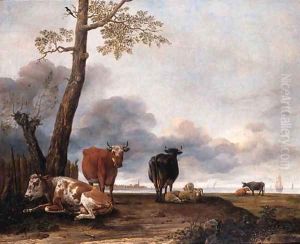Anthonie Cornelisz. Van Borssom Paintings
Anthonie Cornelisz. van Borssom, also known as Anthonie van Borssom or Antonie van Borssom, was a Dutch artist born in the early 17th century in Amsterdam. His exact birth date is not definitively known, but it is often cited as 1630 or 1631. Van Borssom is primarily known for his landscape paintings, which typically depict serene Dutch countryside scenes with meticulous attention to the details of flora and fauna.
Van Borssom was a pupil of the celebrated landscape painter Rembrandt van Rijn, which is evident in the quality of light and shadow in his works. However, van Borssom developed his unique style, characterized by a more delicate and detailed approach as opposed to Rembrandt’s broader and more dramatic technique. His paintings often featured dunes, forests, and river scenes populated with small figures and animals, rendered with fine brushwork and a keen observation of nature.
Despite his talent, Anthonie van Borssom was not as well known as some of his contemporaries. He spent most of his life working in Amsterdam and did not receive the same level of recognition as other Dutch Golden Age artists. He did, however, produce a substantial body of work, including drawings and watercolors, which have been important for studies of 17th-century Dutch landscape painting.
Van Borssom died in 1677, in Amsterdam. His works can be found in various art collections and museums around the world, appreciated for their tranquil beauty and the artist’s skill in capturing the essence of the Dutch landscape. Although he did not achieve significant fame during his lifetime, his contribution to Dutch art has been reassessed over time, and he is now regarded as a noteworthy figure from the period.
